Douglas DC-4
| DC-4 | |
|---|---|
 |
|
| Douglas DC-4-1009 of KLM Royal Dutch Airlines, built March 1946, in service in August 1954 | |
| Role | Airliner/transport aircraft |
| National origin | United States |
| Manufacturer | Douglas Aircraft Company |
| First flight | 1938 |
| Number built | 79 |
| Developed from | Douglas DC-4E |
| Variants | C-54 Skymaster Canadair North Star Douglas DC-6 Aviation Traders ATL-98 Carvair |
The Douglas DC-4 is a four-engined propeller-driven airliner developed by the Douglas Aircraft Company. It served during World War II, in the Berlin Airlift and into the 1960s in a military role. From 1945, many civil airlines operated it worldwide.
Contents |
Design and development
The designation DC-4 was first used by Douglas Aircraft Company when developing a large, four-engined type to complement its very successful DC-3, already in widespread operation. It was intended to fulfil United Airlines' requirement for a long-range passenger airliner. Retrospectively this aircraft became known as the DC-4E (E for experimental). It emerged as a 42-passenger airliner with a fuselage of unusually wide cross-section for its day and a triple fin tail unit, similar to that later used by Lockheed on its Constellation. The triple fin and double deck were abandoned on subsequent models, and the more common single fin was utilised.
The DC-4E first flew on 7 June 1938, piloted by Benny Howard and was used by United Air Lines for test flights. The type proved to be ahead of its time: it was complicated to maintain and uneconomical to operate. The sponsoring airlines, Eastern and United, decided to ask instead for a smaller and simpler derivative, but before the definitive DC-4 could enter service the outbreak of the Second World War meant production was channeled to the United States Army Air Forces and the type was given the military designation C-54 Skymaster. Additional versions used by the US Navy were designated R5D. The first aircraft, a C-54, flew from Clover Field in Santa Monica, California on February 14, 1942.
Production
The DC-4 had a notable innovation in that its tricycle landing gear allowed it to incorporate a fuselage of constant cross-section for most of its length. This lent itself to easy stretching into the later DC-6 and DC-7. A total of 1,163 C-54/R5Ds were built for the United States military services between 1942 and January 1946.
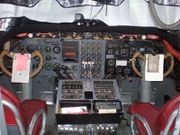
Douglas continued to develop the type during the war in preparation for a return to airline services when peace returned. However, the type's sales prospects were hit by the offloading of 500 wartime C-54s and R5Ds onto the civil market. DC-4s were a favorite of charter airlines such as Great Lakes Airlines, North American Airlines, Universal Airlines, Transocean Airlines, etc. In the 1950s, Transocean Airlines (Oakland, California) was the largest operator of the C-54/DC-4.
Douglas produced 79 new-build DC-4s between January 1946 and cessation of production on 9 August 1947. Pressurization was available as an option, but all civilian DC-4s (and C-54s) were built unpressurized. Purchasers of the new build aircraft included National Airlines, Northwest Airlines and Western Airlines in the USA and KLM Royal Dutch Air Lines, Scandinavian Airlines System, Sabena Belgian World Airlines and South African Airways in overseas markets.[1]
The DC-4 featured extensively in the 1954 John Wayne motion picture The High and the Mighty (film).
Variants
- DC-4-1009 Postwar passenger model. This civil model could carry up to 86 passengers.
- DC-4-1037 Postwar freight model.
Derivatives
- DC4M North Star - 71 DC-4s were built by Canadair under the designations North Star, DC-4M, C-4, and C-5. With the exception of the single C-5, these were all powered by Rolls-Royce Merlin engines and 51 of them were pressurized. The Royal Canadian Air Force, Trans-Canada Air Lines, Canadian Pacific Air Lines and BOAC operated these aircraft, the latter under the type name "Argonaut".
- Aviation Traders Carvair - Starting in 1959, 21 DC-4s and C-54s found new life as ATL-98 Carvairs. The Carvair was designed to carry 22 passengers and 5 automobiles. This was accomplished by extending the fuselage, moving the cockpit above the fuselage, adding a side-opening nose, and enlarging the vertical stabilizer to offset the larger forward fuselage. These planes served as flying ferries well into the seventies, and two are still airworthy as of March 2008 - one each in Texas and South Africa.
Operational history
The DC-4/C-54 proved a popular and reliable type and several remain in service as of 2007. An example is Brooks Fuel of Fairbanks, Alaska.[2]
Operators
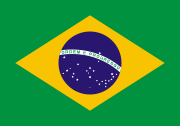 Brazil
Brazil
- Aerovias Brasil
- Cruzeiro do Sul
- Lóide Aéreo Nacional
- Paraense Transportes Aéreos
 Canada
Canada
- Trans Canada Airlines
- Buffalo Airways
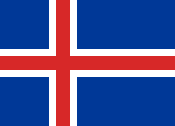 Iceland
Iceland
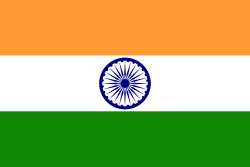 India
India
- Indian Airlines
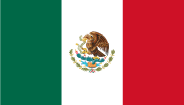 Mexico
Mexico
- Mexicana
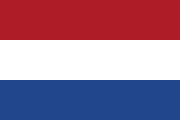 The Netherlands
The Netherlands
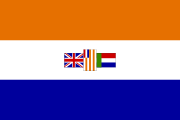 South Africa
South Africa
- South African Airways
- Trek Airways[3]
 South Korea
South Korea
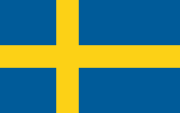 Sweden
Sweden
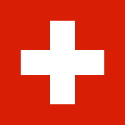 Switzerland
Switzerland
 United States
United States
- American Airlines
- Braniff International Airlines
- Brooks Fuel
- Capital Airlines
- California Central Airlines
- Delta Air Lines
- Northwest Airlines
- Pacific Southwest Airlines
- Pan American World Airways
Survivors
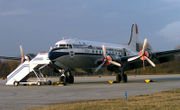
Very few DC-4s remain in service today, though 26 remained airworthy in 2007[4] including C-54s. The last three passenger DC-4s believed to be running worldwide are all based in Johannesburg South Africa. Two fly old South African Airways (SAA) colors. They are ZS-AUB "Outeniqua" and ZS-BMH "Lebombo" and are owned by the South African Airways Museum Society[5] and operated by Skyclass Aviation[6], a company specializing in classic airliner charters to exotic destinations in Africa. The other Skymaster is ZS-AUA "Tafelberg" which is also operated by Skyclass Aviation but is leased from the Dutch Dakota Association. A further C54 at Rand Airport is owned by Phoebus Apollo Aviation, ZS-PAI, Between 1998 and 2002, Phoebus Apollo operated a successful African cargo operation with 3 DC4's and a single Carvair. AVGAS availability and cost saw the company expand into jets. ZS-PAK was cut up, ZS-PAJ was donated to the South African Airways Museum Society and ZS-PAI is used for airshows. The only operator of DC-4s in Canada is Buffalo Airways of Yellowknife, Northwest Territories. They operate two in the cargo role, C-GPSH 'Arctic Distributor' and C-GCTF, two as water bombers and another ten registered with Transport Canada, all fourteen as C-54s.[7][8][9]
Specifications (DC-4-1009)
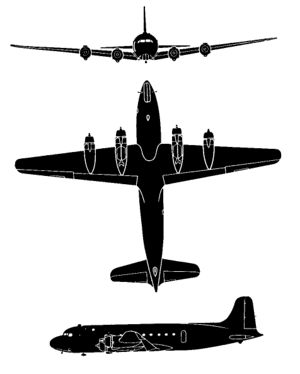
General characteristics
- Crew: 4
- Capacity: Up to 86 passengers
- Length: 93 ft 10 in (28.6 m)
- Wingspan: 117 ft 6 in (35.8 m)
- Height: 27 ft 6 in (8.38 m)
- Wing area: 1,460ft² (135.6 m²)
- Empty weight: 43,300 lb (19,640 kg)
- Loaded weight: 63,500 lb (28,800 kg)
- Max takeoff weight: 73,000 lb (33,100 kg)
- Powerplant: 4× Pratt & Whitney R-2000 radial engine, 1,450 hp (1,081 kW) each
Performance
- Maximum speed: 280 mph (450 km/h)
- Cruise speed: 227 mph (365 km/h)
- Range: 4,250 mi (6,839 km)
- Service ceiling: 22,300 ft (6,800 m)
- Wing loading: 43.5 lb/ft² (212.4 kg/m²)
- Power/mass: 10.9 lb/hp (6.6 kg/kW)
See also
Related development
- Douglas DC-4E
- C-54 Skymaster
- Canadair North Star
- Aviation Traders Carvair
- Douglas DC-6
- Douglas DC-7
Comparable aircraft
- Boeing 307
- Lockheed Constellation
Related lists
- List of airliners
- List of aircraft
References
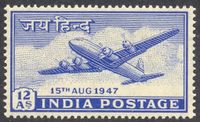
- ↑ Berry, 1967, pp. 70-73
- ↑ Stapleton, Rob. "Brooks Fuel keeps Alaska supplied using legacy aircraft", Alaska Journal of Commerce. August 15, 2009. Accessed August 26, 2009.
- ↑ [1]
- ↑ Blewett p.101
- ↑ South African Airways Museum Society
- ↑ Skyclass Aviation
- ↑ http://www.buffaloairways.com/douglas_dc-4b.htm
- ↑ Douglas DC-4 Retardant Tankers
- ↑ Enter "C54" in "Model name"
Bibliography
- Berry, Peter and others, The Douglas DC-4, 1967, Air-Britain (Historians) Ltd, ISBN - none
- Blewett, R. Survivors (2007). Coulsden U.K.: Aviation Classics. ISBN 978-09530413-4-3.
- Francillon, René (1979). McDonnell Douglas Aircraft Since 1920: Volume I. London: Putnam. ISBN 0-87021-428-4.
- Pearcy, Arthur (1995). Douglas Propliners: DC-1–DC-7. Shrewsbury: Airlife Publishing. ISBN 1-85310-261-X.
- Yenne, Bill (1985). McDonnell Douglas: A Tale of Two Giants. Greenwich, Conn.: Bison Books. ISBN 0-517-44287-6.
External links
- Boeing McDonnell Douglas page on DC-4
- The last passenger certified & built DC-4's in the world
- Vintage Wings of Canada Canadair North Star showing RR Merlin installation
|
|||||||||||
|
|||||
|
||||||||||||||